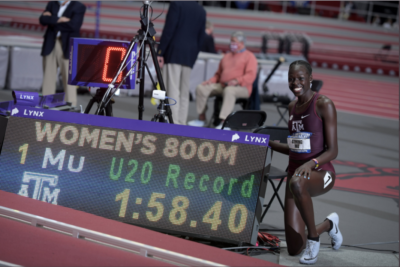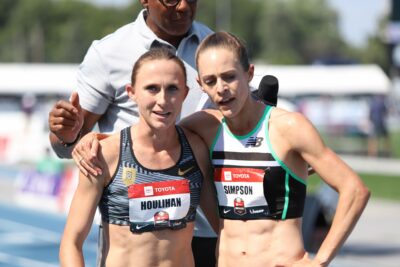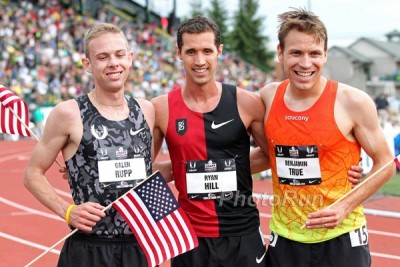Which American Athletes Were Helped — And Hurt — the Most by the Olympic Postponement?
By Jonathan Gault
May 5, 2021
When the Tokyo Summer Olympics were officially pushed back a year in March 2020, we knew it would affect the composition of the US Olympic track & field team. Just as the US did not send the same team to the 2015 World Championships as it did to the 2016 Olympics, the roster it will send to Tokyo in July will differ from the one it would have sent last summer. Younger athletes have had an extra year to develop; older athletes have had an extra year to decline, with the impact being biggest at the extremes. One year of extra maturation is a much bigger deal in a positive way for a teenager than a 25-year-old and one year of extra age is a much bigger deal in a negative way for a 35-year-old than a 25-year-old.
Additionally, some injured athletes have healed, while some healthy athletes have become injured.
But enough with generalities. Let’s get specific. After combing through the contenders at this summer’s US Olympic Trials, here are the athletes whom the Olympic postponement helped — and hurt — the most.
HELPED: Jaylen Slade/Erriyon Knighton
One year can make an enormous difference at the high school level. Slade, who ran 10.03 (+2.7 wind) and 20.20 last weekend, and Knighton (9.99 with +2.7 wind) would not have been factors at the Olympic Trials as 16-year-olds. But now, at 17, they will have the chance to compete there and launch their careers in much the same way Noah Lyles and Michael Norman did at the 2016 Trials.
HELPED: Cole Hocker & Athing Mu
Hocker, the 19-year-old miler from Oregon, and Mu, the 18-year-old 800 star from Texas A&M, have been the breakout stars of the 2021 collegiate season. Hocker ran a 3:50 mile indoors before claiming NCAA indoor titles in the mile and 3000, while Mu broke the collegiate record at 800 meters both indoors (1:58.40) and outdoors (1:57.73). Both now have strong chances to make the US team in Eugene — and perhaps contend for a medal in Tokyo.
One side effect of the limited race opportunities in 2020 is that breakouts like Hocker’s and Mu’s have appeared even larger than they normally would have. Hocker did qualify for NCAA indoors last year as a freshman at Oregon, but never got to compete at the meet or run an outdoor season at all. So even if Hocker may have been fit enough last summer to make an NCAA or even USA final, we didn’t get to see that fitness on the track. Likewise with Mu, who didn’t race at all in 2020 after February. Had she competed last summer, there’s a decent chance we would have seen her go 1:59, rather than making a humongous leap from 2:01 to 1:57 this year.
Mu would have been in contention for an Olympic spot in 2020 — she was 5th at USAs in 2019 as a 17-year-old — but would not be regarded a favorite to make the team. Hocker may not have been in contention at all; it is hard to imagine a true freshman grabbing a spot on the men’s 1500 team, even one as precocious as Hocker.
HELPED: Elise Cranny & Grant Fisher
Jerry Schumacher is one of the world’s greatest coaches, but there is often an adjustment period for athletes upon joining the Bowerman Track Club, during which time they learn how to handle the intensity of Schumacher’s workouts. We saw it with Shelby Houlihan, who became one of the world’s best runners in her third full year under Schumacher in 2018, and we’re seeing it now with Cranny and Fisher, the former Stanford teammates who joined BTC in 2019.
Fisher and Cranny, both 24, may have made the Olympic team last summer, but they’re in even stronger positions in 2021. Cranny ran 14:48 for 5,000 in 2020 and, more impressively, clocked 30:47 in her 10,000 debut in February 2021, good for #3 all-time in the US. Fisher, meanwhile, is also a serious threat to make the team at both distances, as he is the 2021 US leader at both 5,000 (13:02) and 10,000 (27:11).
HURT: Paul Chelimo, Lopez Lomong
This isn’t to say that these two won’t still make the team. But are they in a better spot in 2021 than they were in 2020? The answer is no.
Lomong’s late-career resurgence is remarkable, and he managed to run his fastest 5,000 ever — 12:58 — last summer at age 35. That’s a great time, and would have put him in a great spot heading into Tokyo. But there aren’t many examples of elite professional athletes who are faster at 5,000 meters at age 36 than they were at 35.
At 30, Chelimo doesn’t have to worry about the actuarial curve quite as much, but he faces another issue, one Lomong must also confront: increased competition. Guys like Emmanuel Bor, Grant Fisher, and Joe Klecker are all better than they were a year ago. Cooper Teare and Cole Hocker are bigger factors than they were in 2020. Woody Kincaid and Ben True are still around.
If Chelimo and Lomong are at their best, they can still make the team and find success in Tokyo. But their path to the Games is harder than it was a year ago.
HELPED: Isaac Updike, Mason Ferlic
Like Hocker and Mu, Updike and Ferlic are two guys whose progress in 2020 is a little hard to measure considering neither ran their specialty event, the steeplechase. Clearly, as shown by their 8:17 (Updike) and 8:18 (Ferlic) pbs at the USATF Grand Prix, both are better steeplers than when they entered the pandemic with pbs of 8:25 (Updike) and 8:21 (Ferlic).
Aside from their personal progression, they’ve also benefited from the absence of Andy Bayer, who announced his retirement earlier this year. Bayer, with an 8:12 pb, is one of just five Americans with the Olympic standard and logged back-to-back top-3 finishes at USAs in 2018 and 2019. Had the Olympics run on schedule in 2020, he would have been ahead of Updike and Ferlic in the pecking order. But Bayer’s Nike contract expired at the end of 2020 and he opted to get a job at a marketing company to support his family, clearing the way for new blood.
HURT: Jenny Simpson
This isn’t based solely on Simpson’s rough 4:10 season opener on April 24 (though that didn’t help). Even if Simpson does rebound, is she, at 34, going to be faster than she was last year? In 2020, she looked good in winning both of her indoor races and was not far removed from clocking 3:58 in the World Championship final in 2019. Of course, she’s still not that far removed from that race, but it’s going to be that much tougher for her to chase down rivals Shelby Houlihan in Elle Purrier — both of whom are in the middle of their primes — than it was in 2020.
HURT: Justin Gatlin
Yes, he did just beat Andre De Grasse and Noah Lyles in his most recent 100 on April 17. But Gatlin is 39 years old. He has displayed uncommon longevity, but he has already shown signs of decline (even though he remains world-class). There is no way the Olympic postponement helped him.
HELPED: Ben True
You may have noticed a pattern here — most of the athletes hurt by the postponement are rather old (in elite runner terms). Athletes don’t typically improve once they hit their mid-30s. But a few developments have helped put True, 35, in a better position than a year ago. For one, he is healthy again, logging a big year of training after spending much of the 2019 campaign battling an Achilles injury. Two, he’s been rejuvenated in practice now that he has a training partner in Dan Curts. And three, he lost his Saucony contract.
The third point may have hurt True from a financial perspective, but it has increased his chances of making the Olympic team as he can now train and race in Nike’s superspikes, which helped propel him to a lifetime best of 27:14 for 10,000 in February.
HURT: Allie Ostrander
Ostrander wasn’t exactly 100% at this time last year, having undergone PRP therapy in April to treat an Achilles injury that had bothered her for months. Had the Olympics not been postponed, however, Ostrander likely would have delayed the therapy and tried to run while continuing to manage the injury. And to that point, she had been managing it pretty well, running a pb of 9:30 in the steeple at the World Championships in 2019 and clocking a pb of 8:48 in the flat 3000 to win at Millrose in 2020.
Yet despite receiving treatment for her Achilles last year, Ostrander has not been fully healthy in 2021 either as she was diagnosed with stress reactions in both legs in March. She has not raced since February 2020.
The other bad news is that the US steeple team is even harder to make than it would have been in 2020. Ostrander would have needed one of the US’s “Big Three” (Emma Coburn, Courtney Frerichs, Colleen Quigley) to falter to have a shot at the steeple team anyway, but now she has to deal with ascendant collegian Courtney Wayment of BYU and Leah Falland of On Athletics Club, both of whom have stepped up a level in 2021.






